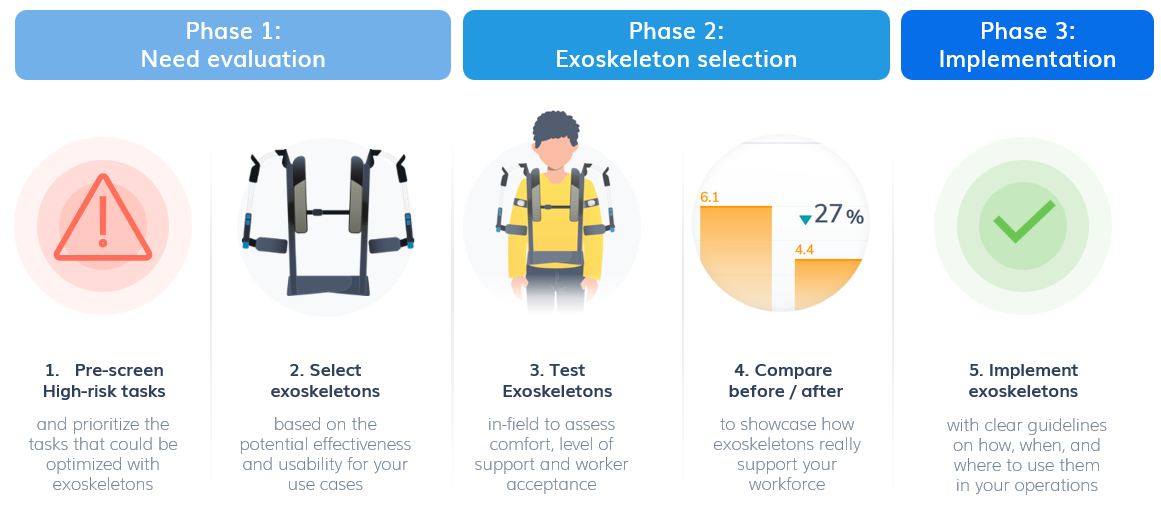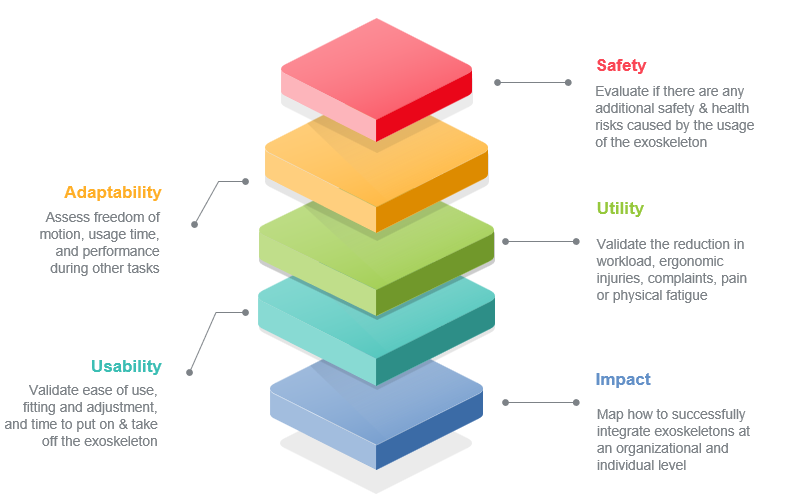Exoskeleton implementation roadmap, best practices, and metrics.
Even if there is no silver bullet for exoskeleton implementation, they can be successfully integrated into daily manual operation by following the right guidelines, best practices, and metrics.
Ergonomic injuries are one of the most common workplace injury categories today. In fact, estimates suggest that over 30% of incidents resulting in days away from work were due to ergonomic-related injuries. Occupational exoskeletons have the potential to decrease the number of musculoskeletal disorders by supporting a posture or movement either mechanically (passive exoskeletons) or with external power (active exoskeletons).
The process to select and implement an exoskeleton suit in an occupational or industrial environment must be carefully planned. But even before that, it is important to understand what exoskeletons are and are not for:
- Exoskeletons are not a one-size-fits-all solution: each exoskeleton is designed for a certain ergonomic application so operational tasks should be assessed individually.
- Exoskeletons do not substitute other preventive measures: exoskeletons fall within the lower part of the Hierarchy of Control, meaning that they can be considered personal protective equipment. Therefore, they do not eliminate ergonomic risk factors but should be used as a last resort to complement existing preventive measures.
- Exoskeletons are not for working more but for working safer: the goal of most exoskeletons is not that workers can lift heavier loads, work longer hours, or execute ergonomically riskier tasks. The objective is that workers can perform their usual daily tasks without getting injured or suffering from musculoskeletal disorders.
- Workers should not be forced to use exoskeletons: the usage of exoskeletons should be voluntary, and workers’ feedback should be considered from the start. Besides, occupational/industrial exoskeletons should only be used by workers without physical limitations.
So, considering all those aspects, what is the best process to successfully implement exoskeletons?

Phase 1: Need evaluation
The goal of the first phase is to answer the question: Are there better non-exoskeleton-related solutions?
Ergonomic risks should always be controlled following the Hierarchy of Control principles: avoiding or eliminating the risk, substituting or controlling the risk, and as a last resort, using personal protective equipment such as exoskeletons. Therefore, exoskeletons should be considered as an additional alternative within a broader portfolio of solutions to improve ergonomics. In other words, before committing to an exoskeleton, a company should check whether there are other ‘simpler’ solutions available.
If exoskeletons are identified as a potential solution for a given use case, each operational task that could be improved should be clearly defined in terms of body parts/movements involved, the number of repetitions and cycle times, load weights, task duration, breaks, as well as the characteristics of the working environment. This analysis should be performed for every task because exoskeletons are not a universal solution to ergonomic risks, a valid exoskeleton for one task could be inadequate for another one.
Phase 2: Exoskeleton selection
The goal of the second phase is to answer the question: Are exoskeletons suitable for my workers?
Once the ergonomic requirements of every task have been defined, the best-fitting exoskeletons should be tested. Making a good analysis of the usability and potential effectiveness of an exoskeleton before implementation is crucial. Following is an overview of the main elements within a holistic exoskeleton evaluation:

Preliminary testing can be conducted in a laboratory setting using subjective questionnaires and objective techniques such as electromyography. Even though in-lab testing could be beneficial in some cases, it can drastically increase the cost of implementation, particularly if it requires advanced measurement equipment. Therefore, an in-field pilot test is always recommended as the key stepping stone to implementing exoskeletons. The preferred approach is to collect subjective and objective data with and without the exoskeleton for every task. By doing so, it is possible to compare the impact of the exoskeleton in various operational environments with clear KPIs.
In all cases, worker acceptability is key so collecting feedback from real workers in the field should be prioritized. If the exoskeletons fulfill the technical requirements but workers do not want to use them the implementation will not succeed. To reach a high level of acceptance, workers have to feel the positive effects of the exoskeleton. Besides, workers should receive detailed instructions on how to use and adjust the exoskeletons, and adequate training to avoid stigmas about their usage.
In most cases, workers need at least 2-3 weeks to get used to the exoskeleton but they should not start using exoskeletons during the whole work shift from the start. It is recommended that workers progressively incorporate exoskeletons, starting for example, with 30 mins and increasing the daily usage until the total duration of the task is reached. After that period, workers can provide more realistic feedback as to whether the exoskeleton really helps them during their daily tasks. Ideally, the workers who volunteered to use the exoskeleton for the in-field pilot would want to continue using it and even recommend their colleagues to do the same.
Phase 3: Implementation
The goal of the third phase is to answer the question: Has safety and health improved with the use of exoskeletons?
Once exoskeletons have been implemented for an extended period, their positive or negative long-term impact should be evaluated compared to the previous situation. The exoskeleton impact KPIs could be both soft and hard metrics such as worker complaints, worker satisfaction, work injuries, or absenteeism.
In addition, the return on investment (ROI) of exoskeletons should also be taken into consideration. The initial price of the exoskeleton is important to calculate the costs but it is also important to factor in other internal and external costs to obtain a more accurate estimation of the total cost of ownership. On top of assessing the long-term impact of exoskeletons, workers and supervisors should receive proper training and implementation policies should be created to ensure that logistical aspects such as storage, replacements, and repairs of exoskeletons are taken care of.
SOURCES
Discussion paper: The Impact of Using Exoskeletons on Occupational Safety and Health. EU-OSHA, 2019.
Álvarez Bayona, Teresa y col. Ergonomía participativa. Un enfoque diferente en la gestión del riesgo ergonómico. Madrid: INSST, 2020. Notas Técnicas de Prevención: NTP 1137.
Christian, Dahmen et al. Approach of Optimized Planning Process for Exoskeleton Centered Workplace Design. Procedia CIRP. 2018, vol 72; 1277–1282.
Goldenhar, Linda et al. The Intervention Research Process in Occupational Safety and Health: An Overview From the National Occupational Research Agenda Intervention Effectiveness Research Team. Journal of Occupational and Environmental Medicine. Agosto 2001, vol 43 (7); 616-622.
Institut National de Recherche et de Sécurité. Acquisition et integration d’un exosquelette en entreprise: Guide pour les pré-venteurs. París, INRS, 2019.